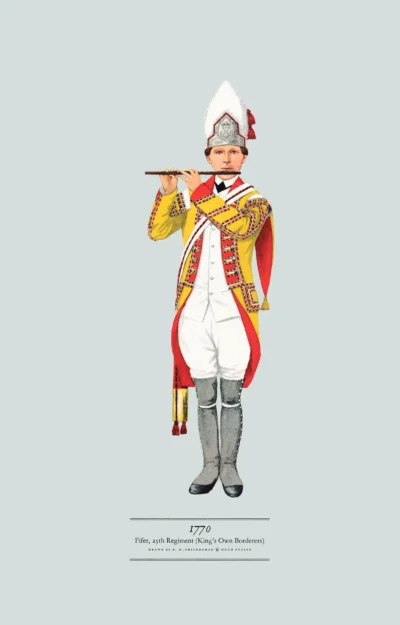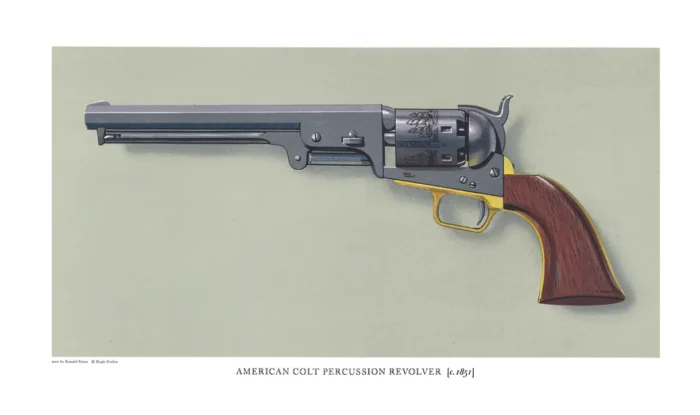American Colt Patent No. 1848 Percussion Revolver, 1851
£17.50
American Colt Patent No. 1848 Percussion Revolver, 1851 (scroll down for a more detailed Description)
Published 1963 by © Hugh Evelyn Limited; drawn by Ronald Paton
Size: c. 43 x 25.5 cm [17 ″ x 10 ″] may vary slightly from printers’ cut 50 years ago
Printed on white cardstock weighing 112 g/sm2
Print is LARGE size – shipping is the same for 1 to 10 prints (based on largest print size in your order) – see Shipping & Returns
In stock
Description
Colt weapons are justly famous. It was not so much for the weapon itself as for the aura of history with which it is surrounded. Colt revolvers were first used in the Seminole uprising in 1847 during the Mexican American War (1846-48) which was soon followed by the American Civil War (1861-65), which impressed itself indelibly on American History. Then came (for some) the occupation of the American West. Popularity and publicity were not, in the view of Samuel Colt (1814-1862) matters left to chance. Good impressions and publicity were always to the fore. A strong feature of Colt weapons was their interchangeability of parts which strongly commended them for use as a martial arm by men who spent their lives far from the services of a gunsmith. He welcomed the invitation to display his guns at the Great Exhibition in London in 1851 and was quick to detect the interest shown in his weapons. It is a tribute to the acumen and drive of the man that by 1853 he put into operation a factory in London on the bank of the Thames. The year 1851 saw the introduction of another model of the already famous Colts – the Navy belt pistol, or model of 1851 a cap and ball revolver. The Navy Model shown here was made at Hartford Connecticut and is equalled in popularity only by the Colt 1860 Single Action, Army Model, which was the official sidearm of the Union Forces in the Civil War, and by the Colt 1873 Single Action Army Model (better known as the Peacemaker) which played such an important part in the opening of the West. This model, No. 4818 (which number appears five times on the pistol) has a walnut butt, brass butt straps and trigger guard, and blued steel barrel, cylinder, ramrod and trigger. Since it is not of solid frame construction, the weakness in having the barrel secured by a flat pin through the cylinder shaft and a catch at the bottom strap, manifests itself in the play that can occur between the barrel and cylinder. There was also a tendency for small fragments of spent percussion caps to find their way into, and impede, the working of the mechanism. Decoration was not a feature of revolvers except for special orders and presentation pieces. The regulation ·36 calibre Navy Model did, however, have some delightful engraving of sailing ships on its 6-chambered cylinder. This is a commemorative engraving of an engagement between the Texas Navy and Mexican ships and bears alongside it the legend ‘Engaged 16th May, 1843’ (date of the naval Battle of Campeche). On the cylinder also is stamped ‘Colts Patent No. 4818’ and ‘Engraved by W. L. Ormsby, New York’. Waterman Ormsby (1809-1883) was an American engraver and inventor who founded the Continental Bank Note Company and invented a pantographic engraving machine called the grammagraph to produce “roll-die” engraving on metal). It is a tribute to the design and mechanics of these early revolvers that, superficially, they have changed very little over the last hundred and fifty years.
Additional information
| Weight | 0.0122 kg |
|---|---|
| Dimensions | 43 × 25.5 cm |

 1910 Lanchester 28
1910 Lanchester 28  London & North Western Railway, 1847
London & North Western Railway, 1847  Fifer, 25th Regiment (King's Own Borderers), 1770
Fifer, 25th Regiment (King's Own Borderers), 1770  Brescian Flintlock Pistol by Lazarino Cominazzo c. 1700
Brescian Flintlock Pistol by Lazarino Cominazzo c. 1700 



